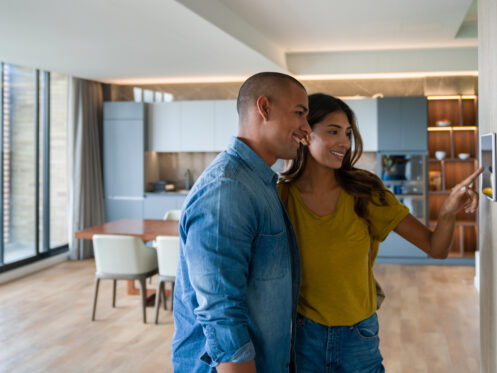Smart home technology and home automation have reached the point where the majority of homes now have at least some smart devices, such as door locks, cameras, etc. Although the main purpose of most smart home technology is to make life more convenient or improve home security, it can also make a major difference in a home’s energy efficiency. This is especially true if you integrate smart technology into your HVAC system, and this article will explore some of the best options for doing so and show you what benefits they can provide.
Integrating HVAC With Your Smart Home Technology
The first step to achieving a “smart” HVAC system is obviously to upgrade your home with a smart thermostat. As with any type of smart technology, a smart thermostat connects to a home’s Wi-Fi network so that it can be controlled remotely on any mobile device with an app. Smart thermostats have been proven to improve HVAC energy efficiency and can easily help you save 10% or more on your air conditioning and heating costs. This is especially the case if you choose an ENERGY STAR-certified smart thermostat.
To earn an ENERGY STAR certification, a smart thermostat must be independently tested and show that it provides a noticeable improvement in efficiency and a reduction in energy usage. The thermostat also has to have a feature on its app that enables you to monitor how much energy your HVAC system is using and provide recommendations on how you can reduce energy consumption by making certain changes to your temperature settings.
While installing a smart thermostat is always the first step, there are many additional ways that you can integrate your HVAC with other types of smart home technology. For instance, you can connect the thermostat to your smart home hub or virtual assistant so that you can control it using voice commands instead of needing to open the app.
Many smart thermostats also have a learning feature that works alongside things like smart door locks, doorbell cameras, and occupancy/motion sensors. This allows the thermostat to adjust the temperature settings on its own based on whether anyone is home or not.
The thermostat will also learn from your typical daily behavior so that it can automatically turn the temperature up and down at certain times, such as when you leave for work, get home, and go to bed. By doing so, the thermostat will ensure your house is always at your desired temperature when you’re home and awake. It will then make adjustments when you’re away or asleep so that your HVAC doesn’t run as much in order to save energy.
Other Ways That Smart Home Technology Can Improve Energy Efficiency
Another beneficial option is to incorporate window sensors into your smart home setup. For instance, if your air conditioning activates while there are open windows, you can configure it to send you a notification on your phone to prompt you to close the windows, thus preventing the AC from running unnecessarily. Additionally, you may program it to prevent the AC from turning on when windows are open or to automatically deactivate it when a window is opened.
Most smart thermostats can also monitor the current temperature and weather forecasts and then adjust your home’s temperature accordingly. With this type of weather-monitoring feature, you can set it up so that you receive an alert as soon as the temperature outside has cooled off enough that you can shut your AC off and open the windows.
Installing smart blinds is also a great option that can boost energy efficiency and lower your air conditioning and heating costs. In most homes, windows are by far the biggest source of heat gain and can also be a major contributor to heat loss during the winter. Having the sun streaming in through your windows will always cause the surrounding area to heat up much more. That’s why experts recommend always keeping your windows covered throughout the day in the summer so that your house stays cooler and your AC has to do less work.
In the winter, keeping your windows uncovered will allow your house to stay a bit warmer and lessen the workload on your heating system. You then want to close your window coverings after the sun goes down to help trap heat in and keep cold out. If you have smart blinds, you can just program them to automatically open and close each day at a set time so that your HVAC runs less. On cloudy winter days when you won’t get much heat gain from the sun, you can use your smart home app to close your blinds to again help keep cold out.
One of the best options for improving efficiency and saving money on your energy bills is a zoned HVAC system. Instead of having one smart thermostat that controls the temperature for your entire house, a zoned system breaks the house up into multiple smaller areas that each have a thermostat. You can then use that thermostat to control the temperature for only that zone. That means you can adjust it so that unoccupied areas don’t receive as much heating or cooling and your HVAC runs less.
If you have motion and occupancy sensors, the smart thermostat in any unoccupied zone can automatically switch to a higher or lower temperature. A zoned HVAC system can also greatly improve your comfort by ensuring each zone always stays exactly as warm or cool as you want.
How Smart Home Technology Can Improve Indoor Air Quality
Your HVAC system can always play a role in indoor air quality, such as by filtering or purifying the air or controlling the indoor humidity level. If you have a whole-home air purification system, you can use a smart air quality monitor that will detect pollutants and signal the purification system to run as needed. Similarly, you can integrate smart technology into a mechanical ventilation system so that it replenishes the air in your home with fresh air from outside whenever the indoor air starts getting overly stale and polluted.
If you have a whole-home humidifier or dehumidifier, you can also control it with a smart thermostat. The thermostat will constantly measure the current humidity level and automatically signal the humidifier or dehumidifier to run when needed to ensure your home is never overly dry or too humid. Avoiding high humidity is important for preventing mold issues, while humidity control also makes a major difference in your comfort level.
If you’re looking to upgrade your home or business with a smart thermostat or switch to a zone-control HVAC system, Chris Heating & Cooling is ready to help. We’ve been serving West Chicago and the surrounding areas since 2005 and our experienced team has what it takes to handle all of your indoor comfort and air quality needs. We offer expert heating and cooling installation and have a wide selection of furnaces, air conditioners, heat pumps, boilers, and ductless mini-split systems suitable for homes and businesses of any size. We also specialize in maintenance and repairs and can ensure your HVAC always works efficiently and effectively.
For more information on how we can help you integrate your HVAC into your smart home, contact us today.








